
Dr. Rola Shaheen has a vision. Dr. Shaheen, Chief of Radiology and Medical Director of Diagnostic Imaging at Peterborough Regional Health Centre (PRHC), would like to see every woman 50 and older in Peterborough and the Kawarthas book a mammogram and keep the appointment as a matter of routine — “like a manicure or a facial,” she says.
“Women look after themselves in other ways without giving it a second thought,” Dr. Shaheen says, with a smile. Not because she is joking, but because she is absolutely serious. To Dr. Shaheen, having a mammogram is a no-brainer.
“The Ontario Breast Screening Program does a terrific job of ensuring women are screened for breast cancer,” Dr. Shaheen says. “But we have to do more.”
Her logic is simple. Since we don’t yet know what causes breast cancer, she says, we cannot prevent it. All we can do is detect it as early as possible to curb its otherwise deadly outcome.
“Screening does save lives,” she says.
The proof, she adds, is in the numbers. Over the past few decades, as more women have gone for mammograms and mammography technology has improved, the incidence of women dying from breast cancer has gone down. Thanks to improvements in screening, detection, and treatment, the five-year survival rate is 88% for women and 80% for men.
Dr. Shaheen has also worked in Abu Dhabi, where there is no organized breast cancer screening program. She saw educated women who were so fearful of a breast cancer diagnosis that they avoided talking to their doctors, even hiding lumps, and eventually facing a grim prognosis.
“Why do we, in North America, have better survival rates?” Dr. Shaheen asks. “Everything else in Abu Dhabi is the same. They have doctors, the same ability to treat. What is different here? It’s the screening programs that have made the difference.”
She envisions more work on the education front, so that women understand the remarkable fact that, if detected early, breast cancer rarely kills.

Breast cancer is the single most common cancer in Canadian women: the government predicts that one in nine women will be diagnosed with it in their lifetime. The earlier that breast cancer is detected, the sooner it can be treated and the better the chances of survival. Access to screening programs is key, as research has shown that women who have regular mammograms are more likely to survive breast cancer.
“By the time a woman can feel the mass, it can mean a mastectomy versus a lumpectomy,” Dr. Shaheen says. “The prognosis is much worse. Early detection will save you.”
But screening programs, she adds, are only as good as the equipment that is available. PRHC’s Breast Assessment Centre is equipped with three mammography machines, thanks to generous donations from the community — much of it through Survivors Abreast and the thousands of donors, paddlers, sponsors and volunteers who have contributed to Peterborough’s Dragon Boat Festival over the years.

As she explains, think of a pepper shaker as your breast. The current mammography machines can take a two-dimensional picture of that shaker, and it can take it from both the front and the side. Essentially, that’s what a mammogram is: two images of each breast.
If a shadow is present, there is really no way to know with certainty if it is simply an anomaly on the image or a significant finding. In other words, whether it’s a single speck of black pepper amid otherwise beige powder or a mass of black peppercorns.
This means the woman is called back for further testing: a process that involves worry, fear, and anxiety. Most often needless, as just a small fraction of the women who are recalled are actually diagnosed with cancer.
A three-dimensional mammogram, also known as tomosynthesis or “tomo”, can identify the nature of that shadow with more certainty, because it takes images of the breast in “slices” from many different angles rather than from just the front and the side. This is particularly important for women with dense breast tissue, which is difficult to see through on a two-dimensional mammogram.
“The 3D mammogram can navigate through the tissue with more accuracy, minimizing call-backs and the worry they cause women,” Dr. Shaheen explains.
Medical studies are backing this with extraordinary results, she adds. One comprehensive North American study (Tomosynthesis Mammography Imaging Screening Trial) involving several Canadian centres is already showing significantly more accurate results with 3D imagery, particularly for younger women with dense breasts.
Dr. Shaheen’s eyes light up when she talks about her estimate that three-quarters of women would benefit from the new machines.
“We can’t prevent breast cancer because we don’t know what causes it,” she says. “Yet I believe breast cancer can be defeated. Screening is the key.”
Improving breast screening even further at PRHC’s Breast Assessment Centre means investing $1.9 million to replace aging equipment with three new full-field digital mammography units — one each year over the next three years.
Besides ensuring their ability to continue generating breast images of the highest possible quality, which in turn empowers PRHC’s radiologists to make the most precise observations, this investment will allow the centre to take advantage of new technologies like three-dimensional screening, resulting in decreased call backs for additional imaging and greatly reduced patient anxiety.

According to Dr. Sarah Harvie, lead radiologist at PRHC’s Breast Assessment Centre, when the new hospital opened eight years ago, community donations funded the jump from analog (film) mammograms to the far more sensitive digital technology. The quality of digital images allowed health professionals to provide a greatly improved standard in breast screening.
“We were one of the first hospitals in the region to offer all our patients digital mammography,” Dr. Harvie says. “Donor investment has enabled a standard of care at the Breast Assessment Centre that is on par with the top hospitals across this country.”
Investing in the three new mammography units for the Breast Assessment Centre will ensure that this standard of care remains available in the future.
To make a gift, call 705-876-5000 or visit www.prhcfoundation.ca. Your donation will help save the lives of women and men from across our region.
Leaf’s Story – How donors helped save this mother of three’s life
All photos by Linda McIlwain / kawarthaNOW except where noted.


























